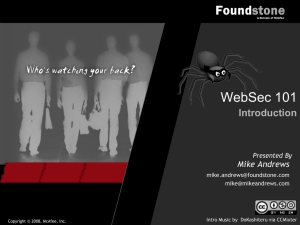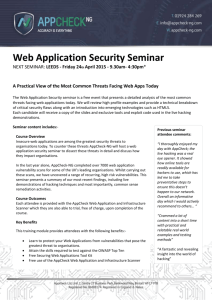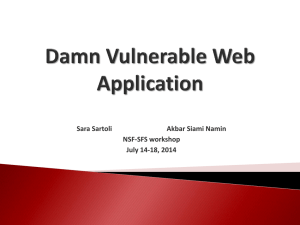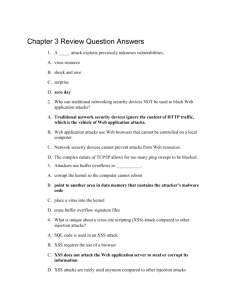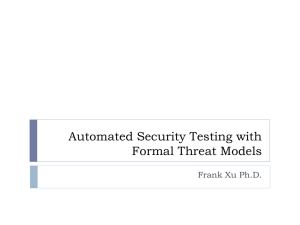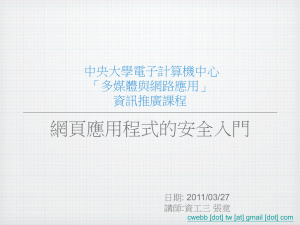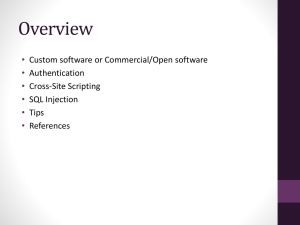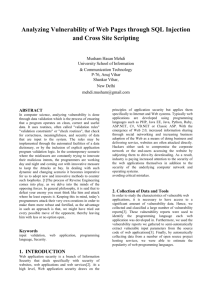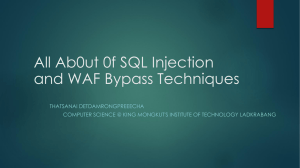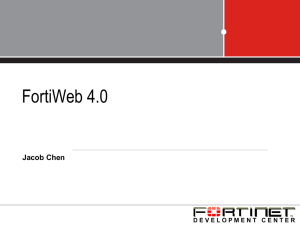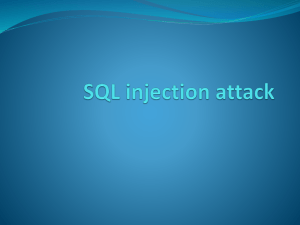ppt
advertisement
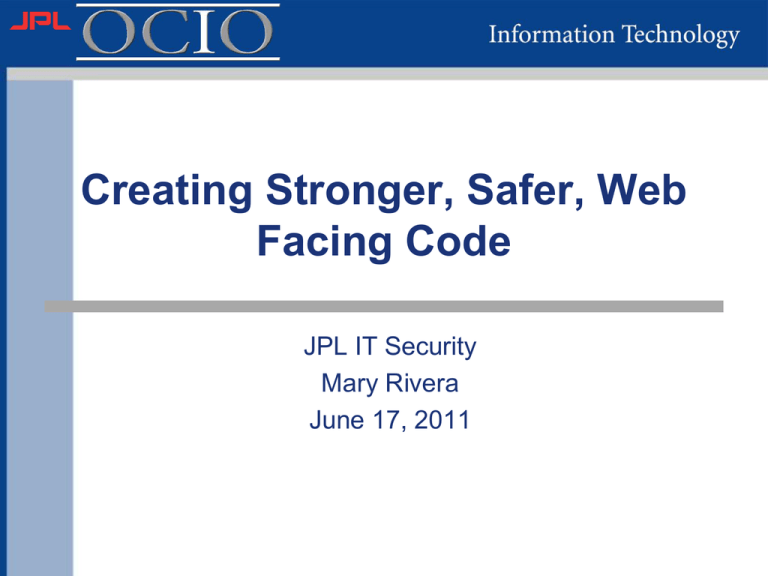
Creating Stronger, Safer, Web Facing Code JPL IT Security Mary Rivera June 17, 2011 Agenda Evolving Threats – Operating System – Application – User Generated Content JPL’s Application Security Program Securing Web applications - Common vulnerabilities - Prevention techniques - Security testing tools Summary 2 10 Years ago… Operating System Attacks – Direct attacks – Buffer Overflow – Denial of Service Mitigation – System administrators got quicker at patch management – Vendors started releasing fixes quicker – Firewalls had better protection 3 3 years ago… Application Threats – Hackers moved up a level from OS to Application – Directed attacks against • SSH • Apache web servers • SQL database servers Mitigation – – – – SA’s got quicker at patch management Vendors started releasing fixes quicker Firewalls had better protection IT Sec started scanning applications not just operating systems 4 Today… User Content Threats – Hackers moved up one more level from application itself to content within the application – Attacking User Content – User generated code • SQL injection, Cross Site Scripting – Neither SA’s nor vendors know how to fix user code Mitigation – Help user become security aware – Security in the Lifecycle – Scan code 5 Half of the Security Incidents involved Applications Problem: – In 2008, 49% of the JPL security incidents involved application vulnerabilities (shown in red). Web Site Unauthenticate d Upload Web Server 3% SSH Brute Force 6% Vulnerability 3% SQL Injection 11% Malware 45% Cross-Site Scripting 32% 6 Agenda Evolving Threats – Operating System – Application – User Generated Content JPL’s Application Security Program << Securing Web Applications - Common vulnerabilities - Prevention techniques - Security testing tools Summary 7 JPL’s Application Security Program App Security Registry Scanning Tools Security in Lifecycle Training & Awareness Security Guidelines 8 JPL Application Security Program Security Guidelines – Programming languages • PERL, ColdFusion, Java – Security checklists Training & Awareness – Developer training courses • Web Application Security • Online AppSec Training tutorials – Quarterly Application Security Newsletter 9 Application Security Program Security in Lifecycle – IT Security checklist – Security process Security Scanning tools – AppScan • Web application testing • Static source code analysis 10 Application Security Program Application Security Registry – Inventory of applications – Technical information about applications for security purposes – Identifies responsible personnel for each application in the inventory 11 Agenda Evolving Threats – Operating System – Application – User Generated Content JPL’s Application Security Program Securing Web Applications << - Common vulnerabilities - Prevention techniques - Security testing tools Summary 12 Common Web Vulnerabilities Open Web Application Security Project (OWASP) Top 10 list – Identifies the most common vulnerabilities Top Vulnerability categories – Injection flaws – Cross site scripting flaws 13 Injection Flaws Allows attackers to execute malicious code through a web application or other system – Access to OS via shell commands – Access to backend Database through SQL • SQL Injection 14 Injection Flaws SQL Injection – Application receives input from a user – Input is sent as part of a database query – Allows malicious users to execute commands on the database Occurs due to: - Improper input validation - Over privileged database logins 15 Potential Effects of SQL Injection Complete access to database Bypass authentication controls Potential command line access from database machine 16 SQL Injection Example Vulnerable Query: – SELECT user FROM Users where loginName = ‘ $User’ and LoginPassword = ‘ $Password’ Injected Query: – Attacker Input: $Password = ‘ OR 1 = 1 -– SELECT user FROM Users where loginName = ‘ jsmith’ and LoginPassword = ‘Demo1234 ‘ OR 1 = 1 -- 17 SQL Injection Example Injected Query: Attacker’s extra input to password: ‘OR 1 = 1 -18 SQL Injection Example Application vulnerable to SQL injection 19 Preventing SQL Injection Use parameterized queries Use input validation Use low privileged accounts Limit error messages OWASP SQL Injection Prevention Cheat Sheet 20 Testing Tools for SQL Injection SQL Inject Me – Firefox add on Other tools – Absinthe – Paros 21 Testing tool for SQL Injection Absinthe 22 Cross-site scripting (XSS) Tricks the browser into executing code – JavaScript, VBScript, ActiveX, HTML, or Flash can be injected into a vulnerable application Application receives input from the user Input is returned back to the user without being sanitized 23 Potential Effects of XSS Redirection Web page contents modified Scripting commands Cookies compromised 24 XSS Example Input String: <SCRIPT>alert(“XSS”)<SCRIPT> 25 Preventing XSS Filter meta characters, scripting, object tags – <script> and <object> Use encoding - HTML encode or URL encode Detailed information on XSS prevention - OWASP XSS Prevention Cheat Sheet 26 Testing Tool for XSS Paros Proxy 27 Summary Changes in threats require keeping pace with changes Secure web applications by – Fixing common web vulnerabilities – Using prevention techniques – Using security testing tools 28 Resources Open Source Web Application Security Project (OWASP) – http://www.owasp.org SQL Injection Cheat Sheet https://www.owasp.org/index.php/SQL_Injection_Prevention_Cheat_Sheet XSS Cheat Sheet – https://www.owasp.org/index.php/XSS_%28Cross_Site_Scripting%29_Prevention_Cheat _Sheet Tools – Paros • http://www.parosproxy.org/download.shtml – SQL Injectme • https://addons.mozilla.org/en-US/firefox/addon/sql-inject-me/ – Absinthe • http://www.0x90.org/releases/absinthe/ 29 QUESTIONS? 30
